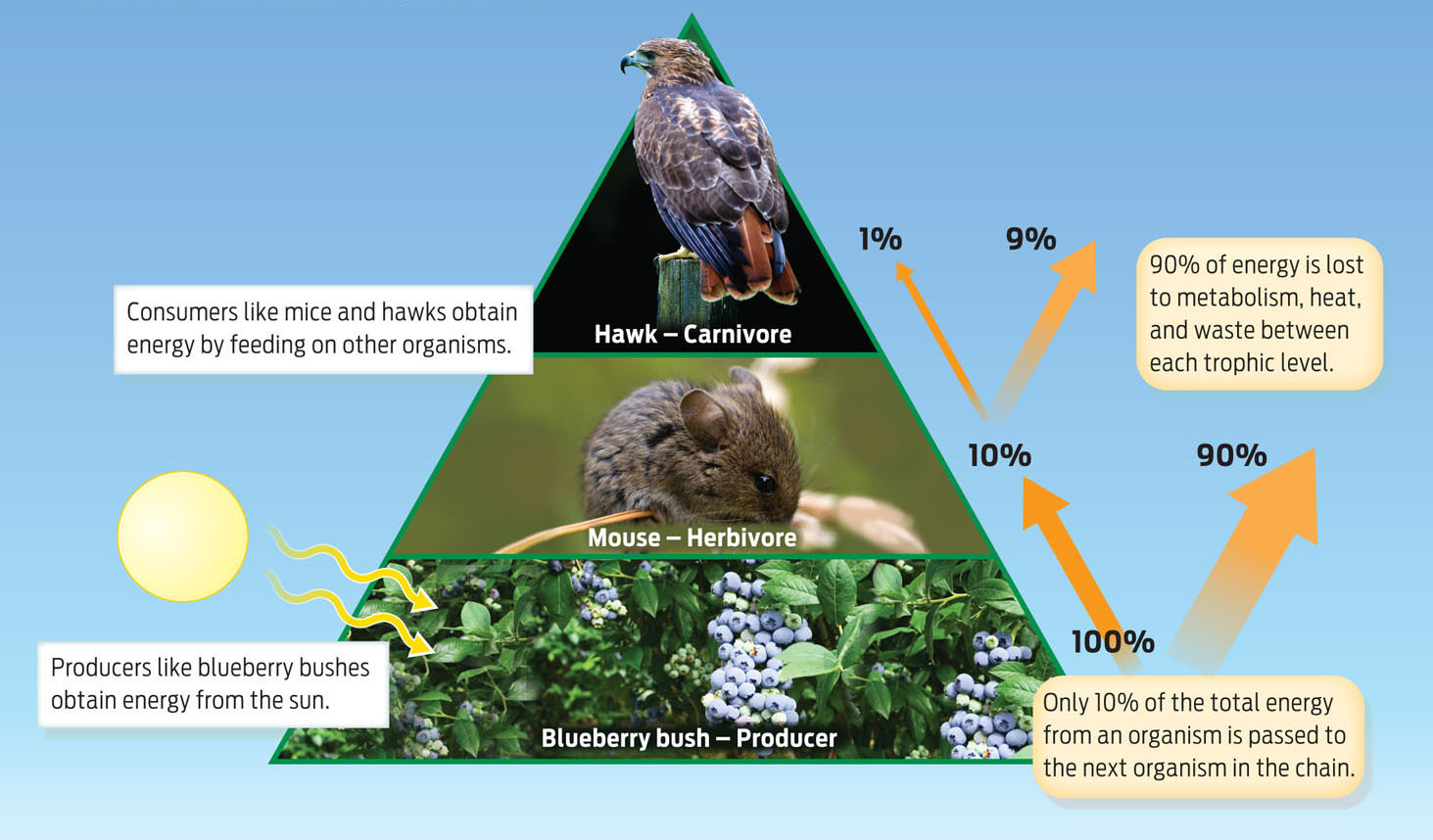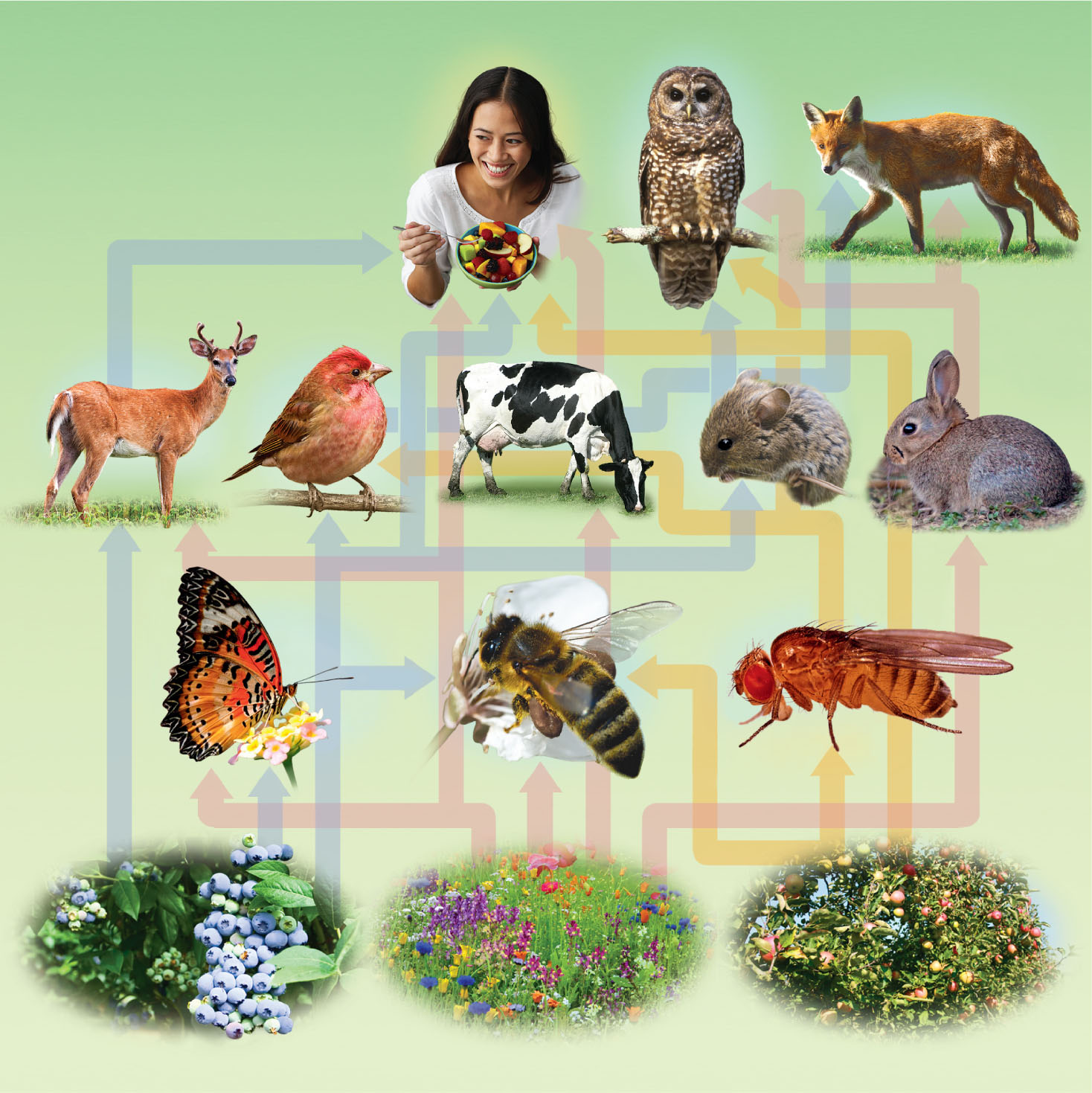A LINK IN THE CHAIN
FOOD CHAIN A linked series of feeding relationships in a community in which organisms further up the chain feed on ones below.
By helping plants reproduce, bees not only help sustain human food production, they also maintain the integrity and productivity of many natural communities. Without these miniature matchmakers, many flowering plants would become extinct, and many birds and mammals would go hungry. That’s because, as keystone species, bees are a critical link in the food chain–the linked sequences of feeding relationships in a community.
PRODUCERS Autotrophs (photosynthetic organisms) that form the base of every food chain.
Take the tiny blueberry bee (Osmia ribifloris), which feeds on the flowers of blueberry plants. This speedy pollinator will visit 50,000 blueberry flowers over the course of a few weeks in spring, helping to produce more than 6,000 blueberries. All those blueberries are an important food source for many wild animals, including bluebirds, robins, fox, mice, rabbits, chipmunks, and deer. In turn, the small animals that eat the blueberries are fed upon by larger carnivorous animals, such as hawks and coyotes. Without the blueberry bee–the keystone in this community–the chain is broken.
CONSUMERS Heterotrophs that eat other organisms lower on the food chain to obtain energy.
Organisms in a food chain can be categorized by who eats whom. At the base of the food chain are producers–autotrophs such as plants and algae, which obtain energy directly from the sun and supply it to the rest of the food chain. Organisms higher up the food chain are consumers–heterotrophic organisms that eat the producers or eat other organisms lower on the chain to obtain energy.
PREDATION An interaction between two organisms in which one organism (the predator) feeds on the other (the prey).
HERBIVORY Predation on plants, which may or may not kill the plant preyed on.
When one organism feasts on another, that’s predation. Usually when we think of predators, we think of large, fierce animals such as wolves hunting moose (see Chapter 21). Predation can also take more subtle forms, however. Feeding on plants, for example, is a type of predation known as herbivory, an activity that may or may not kill the plant. Predators that feed on plants are known as herbivores–bees feasting on nectar and pollen, for example, or a mouse nibbling on a blueberry bush. Herbivores are an important food source for carnivorous consumers higher up the chain.
TROPHIC LEVELS Feeding levels, based on positions in a food chain.
At the top of the food chain are those animals known as top consumers–animals such as coyotes, hawks, and wolves (as well as meat-eating humans), who have no natural predators and are not generally eaten by anything else in the community.
While it might seem preferable to be at the top of a food chain rather than at the bottom, there are downsides to being last in line to eat. For one, it’s harder to obtain the energy necessary to live. As consumers prey on organisms below them in the chain, energy is transferred up the chain through what are known as trophic levels (from the Greek trophe, meaning “food”). But not all the energy stored in a lower level makes it to the level above it; at each step, much of this energy is lost from the chain.
When a mouse feeds on a blueberry bush, for example, most of the energy in the blueberries is either burned (in aerobic respiration) to fuel the mouse’s activities and given off as heat, or passed through the mouse as indigestible plant fiber. Only a very small portion (about 10%) of the energy stored in the blueberries goes to putting weight on the mouse (INFOGRAPHIC 22.4).
In a food chain, energy flows in one direction: from producers to consumers. Producers obtain energy from the sun. Consumers obtain energy by eating producers. As consumers eat other consumers, the flow of energy continues up the food chain. The passage of energy is not efficient, however, as only 10% of energy makes it from one trophic level to the next. The result is an energy pyramid.

This is the main reason top carnivores like coyotes, hawks, and wolves are scarce on earth, and why there are no predators of these creatures: there’s simply not enough energy left in the chain to sustain more of them. (It’s also why human vegetarianism is more energetically efficient than meat-eating: the same amount of a crop can feed many more vegetarians than meat-eaters who eat the animals that eat the crop.)
FOOD WEB A complex interconnection of feeding relationships in a community.
While it’s helpful to think of the food chain as a stepwise series, the food-chain concept is an oversimplification. Many organisms are omnivores (that is, they eat both plants and animals) and so occupy more than one position in the chain. The result is a complex, intertwined food web–like the one that links bees to the food on your breakfast table. This food web includes not just the fruits and vegetables that bees pollinate directly, but the animals that eat bee-pollinated crops and provide us with meat and dairy products (INFOGRAPHIC 22.5).
The intersection of multiple food chains in a community results in a complex food web. Individual organisms in the food web have multiple important roles that keep the community healthy.
